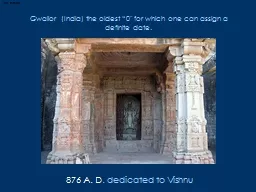

876 A D dedicated to Vishnu Gwalior India the oldest 0 for which one can assign a definite date a piece of land 270 hastas in length 2 7 o One cannot exaggerate how important the invention of zero has been for human development ID: 480447
Download Presentation The PPT/PDF document "The temple" is the property of its rightful owner. Permission is granted to download and print the materials on this web site for personal, non-commercial use only, and to display it on your personal computer provided you do not modify the materials and that you retain all copyright notices contained in the materials. By downloading content from our website, you accept the terms of this agreement.
Slide1
The temple
876 A. D
. dedicated to Vishnu
Gwalior (India) the oldest “0″ for which one can assign a definite date.Slide2Slide3
. a piece of land 270
hastas
in length Slide4
2 7
oSlide5Slide6
One cannot exaggerate how important the invention of zero has been for human developmentSlide7Slide8
Just inside the inner chamber, is the tablet which records the dates relating the temple.Slide9
933Slide10
.. the town gave in perpetual endowment ... for a daily gift of 50 garlands of flowers Slide11Slide12
The Gwalior city is now both sprawling and crowded, with a population of perhaps 2,000,000, but until recently it was relatively small, and designed to be small.
The fort occupies a plateau in what is now the center of the city, but was once on its western boundary. The plateau is about 300 feet high built of basalt, rising steeply from the plain below. It is a bit less than two miles in length from north to south, maybe an average of a half mile from west to east.
The site is of mathematical interest because of what is written on a tablet recording the establishment of a small 9th century Hindu temple on the eastern side of the plateau (marked by the on the nineteenth century map at the left). By accident, it records the oldest “0″ in India for which one can assign a definite date.Slide13
The temple
The temple is dated to 876 A. D. and is much older than the current fort, whose construction was begun in the late 15th century, although it was built quite a while after the original one constructed on the plateau. It is, like many temples in India,
monolithic
- that is to say, originally carved out of one single chunk of stone. It was dedicated to Vishnu, but is no longer an active site of worshipSlide14
The temple is named
Chatur-bhuja
, that of the four-armed god. Who was reponsible for the (literal) defacement of the statue is not known to me.Slide15
Just inside the inner chamber, on Vishnu's right hand side, is the dedication tablet. The tablet records the date (in the local era, which started in 57 B. C.), the dimension of a land grant to a
neighbouring
temple, and the size of a daily gift of flowers to be paid for from an endowment made to this temple.Slide16
Om. Adoration to Vishnu! In the year 933, on the second day of the bright half of the month of
Magha
...Slide17
.. the whole town gave to the temple ... which
Alla
, the son of Vaillabhatta, had caused to be built ... a piece of land ... 270 hastas in length Slide18
.. the town gave in perpetual endowment ... for a daily gift of 50 garlands of flowers Slide19
The history of zero is a bit complicated. So is the history of "0". The scholarly literature on the subject is only tentative because much of the historical record is very sparse, whereas the popular literature is unfortunately and frequently both confident and in error.
The first problem to come along is deciding exactly what one means by "zero" or, for that matter, "0". Is it a number in the mathematical sense - that is to say, the cardinality of the empty set? The length of a point? The result of subtracting
1 from 1? I am not going to engage in such deep matters, but rather in a much more pedestrian business. The digit "0" was a basic part of decimal place value notation. There is no doubt that it was invented in India, but exactly how and for what purpose is unclear, and probably always will be.This is not at first sight very complicated mathematics, but in truth it took far longer for humans to develop a convenient notation for calculating than it did for them to develop rigourous mathematical reasoning. The apparent simplicity of our current system is indeed a sign of its elegance. It often happens that the best mathematics, once seen, is seen to be obvious.
I'm going to cover a very small part of the story.